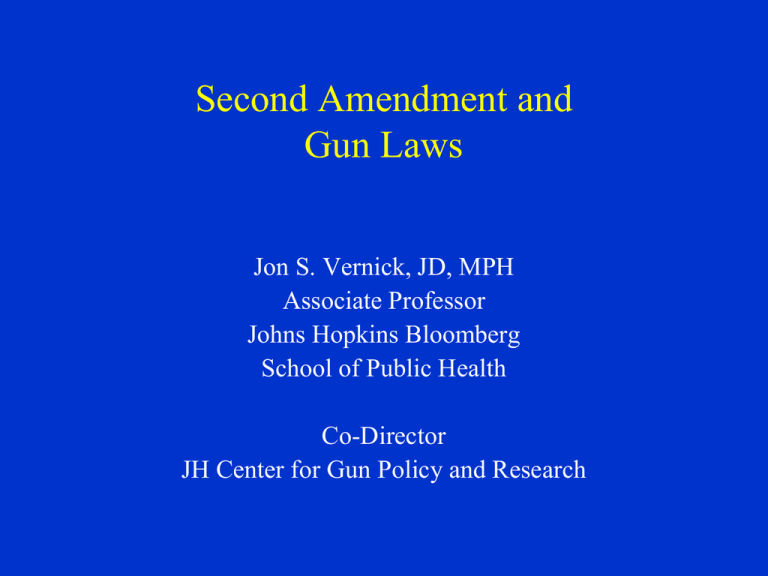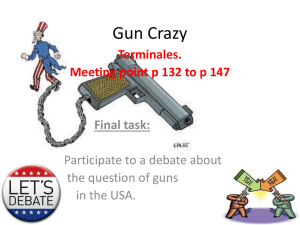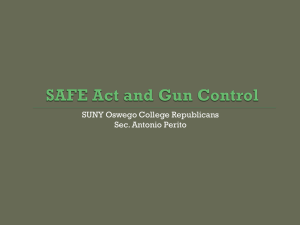Poynter Institute Journalists 2nd Am and Laws 2013
advertisement

Second Amendment and Gun Laws Jon S. Vernick, JD, MPH Associate Professor Johns Hopkins Bloomberg School of Public Health Co-Director JH Center for Gun Policy and Research Guns in the United States • How many? • How do we know? Distribution of Firearm-related Deaths in the United States, 2010 Unintentional: 606 Homicide: 11,078 Homicide Suicide Unintent. Legal Int. Undeter. Suicide: 19,392 Total Firearm Deaths = 31,672 Firearm Homicides by Type of Gun, 2010 Shotgun: 5% Rifle: 5% Handgun: 88% Other guns: 2% Handgun Rifle Shotgun Other Gun Total Firearm Homicides for which Type of Gun is Known = 6,836 Non-Fatal Firearm Injuries • About 2.3 non-fatal firearm injuries for every fatality • An estimated 73,505 in 2010 (requiring at least ED treatment) Source: CDC, WISQARS Second Amendment (excerpt) • “… the right of the people to keep and bear Arms, shall not be infringed.” Second Amendment (Full) • “A well regulated Militia, being necessary to the security of a free State, the right of the people to keep and bear Arms, shall not be infringed.” What Does this Language Mean? • Some disagreement among scholars, advocates, and the public • But until 2007-2008, little/no disagreement among the courts • Until 2007, no federal appellate court had ever struck down any gun law on Second Amendment grounds: even a law banning handgun ownership Why Was There Such Unanimity among Appellate Courts? • 19th century Supreme Court cases said that 2nd Amend. does not apply to state/local laws • “Militia” clause interpreted by most courts as requiring “some reasonable relationship” to militia for a law to be relevant to 2nd Am. • Until 2008, the last Supreme Court case directly addressing 2nd Amend. was in 1939 District of Columbia v. Heller • Challenge to Washington, DC law brought by Mr. Heller with the help of the Cato Institute District of Columbia v. Heller • D.C. law banned handguns (but not long guns) which weren’t owned and registered prior to 1976 • Mr. Heller, a D.C. resident, denied registration. • Federal District Court finds for D.C. • Court of Appeals reverses and Sup. Court grants cert. • More than 30 amicus briefs (including APHA) Heller Decision (June 26, 2008) • Justice Scalia for a 5-4 majority • 2nd Amendment protects a personal right to own handguns in the home • D.C. handgun ban struck down Heller, continued • “Like most rights, the right secured by the Second Amendment is not unlimited.” • “[N]othing in our opinion should be taken to cast doubt on longstanding prohibitions on the possession of firearms by felons and the mentally ill, or laws forbidding the carrying of firearms in sensitive places such as schools and government buildings, or laws imposing conditions and qualifications on the commercial sale of arms.” Heller Left Much Undecided • Vague description of presumptively valid laws • No standard to be applied to judge constitutionality of other gun laws • Application to state/local laws (D.C. is a federal enclave). McDonald v. Chicago (June 28, 2010) • • • • Justice Alito for same 5-4 majority Chicago had banned handguns since 1982 Mr. McDonald a Chicago resident “Incorporated” 2nd Amendment into 14th Amendment as a limit on state/local power • Struck down Chicago handgun ban After Heller and McDonald • Many gun laws challenged • Courts using a variety of approaches and standards • Nearly all laws have been upheld Implications: For the Courts • Must apply general principles of Heller and McDonald without a specific standard • Many have used some form of intermediate scrutiny • Judges will need help with science/data Implications: For Researchers • • • • Need to evaluate laws and policies Expert witnesses needed by both sides Amicus briefs Legal scholars can help courts develop standards Implications: For Policymakers • • • • Presumptively valid laws But remains some uncertainty Cost of legal challenges – chilling effect Many gun laws unlikely to affect core right of handgun ownership in the home – e.g. regulation of gun dealers or gun design • Value of a legislative record – post-Heller DC law upheld Conclusions • Courts have upheld vast majority of existing laws for now • Likely more Supreme Court cases to follow (perhaps on carrying concealed weapons laws) • Some cases to watch, including challenge to Chicago’s far-reaching post-McDonald law Lifespan of a Firearm • • • • • Manufacture Marketing/Distribution Sale Possession Use Ban Certain (High Risk) Firearms? • Assault Weapons • Saturday Night Specials Evaluation of 1994 Federal AWB • Assault weapons rarely used in crime prior to ban (18% of all crime guns) • Decrease in use of AW in crime post-ban • Non-significant 6.7% reduction in homicides associated with the law • Copy-cat weapons readily available (Koper and Roth, NIJ Research-in-Brief 1999) Top 10 crime guns recovered from juveniles and youth traced by ATF, 1999 Juveniles (<18) Youth (18-24) Make, caliber Time to crime (yrs) Make, caliber Time to crime (yrs) Lorcin .380 3.5 Lorcin .380 3.6 S&W .38 15.3 Ruger 9 mm 2.2 Raven .25 12.1 S&W .38 13.1 Davis .380 6.0 S&W 9 mm 4.3 Bryco .380 2.8 Bryco 9 mm 1.2 Bryco 9 mm 1.6 Bryco .380 2.0 Lorcin .25 6.2 Davis .380 5.2 S&W 9 mm 6.1 Raven .25 12.2 Ruger 9 mm 4.0 S&W .357 13.4 Lorcin 9 mm 1.6 Mossberg 12 g 4.3 Evaluation of 1990 Maryland Ban of SNSs • Much smaller proportion of crime guns were SNS’s in Baltimore after the law than in 15 other cities without a ban (Vernick and Webster, Injury Prevention 1999) • Estimated 9% fewer homicides in MD than would be expected without the law; translates to an average of 40 lives saved per year (Webster and Vernick, American Journal of Epidemiology 2002) Change the Design of Firearms to Make Them Safer • Loaded Chamber Indicators • Personalized Guns Lives Potentially Saved by Loaded Chamber Indicators and Personalized Guns In a study using medical examiner data from Maryland and Wisconsin: -- 20 % deaths preventable by loaded chamber indicator -- 37% by a personalized gun -- 442 deaths might have prevented in 2000 if all guns had both devices Source: Vernick et al., Injury Prevention; 2003 Sales Restriction Certain Persons are Prohibited from Purchasing or Possessing Guns: -- Age; Criminal and Mental Health History • Dealers Must be Licensed • Brady Law: Background checks for purchases from licensed dealers • Some States go further: licensing owners and registering guns; 1 gun/mo; universal background checks Evaluations of Sales Restrictions • Brady Law: no difference in change in homicide rates among states affected by Brady compared with those not affected: but big loophole in law. (Ludwig and Cook, JAMA 2000) • Licensing laws reduce gun trafficking And sates with both licensing and registration have a smaller proportion of crime guns coming from in-state. (Webster & Vernick 2009; Webster & Vernick, Injury Prevention 2001) • VA’s 1 gun/month law reduced interstate gun trafficking (Weil and Azrael, JAMA 1993) • Universal background check laws reduce gun trafficking. Oversight of Gun Dealers • 1% of gun dealers sell 57% of crime guns • Undercover stings of gun dealers in Chicago reduced illegal trafficking in new guns by 46% (Webster and Vernick, Injury Prevention 2006) • One Milwaukee gun store’s decision to stop selling SNS reduced illegal trafficking in new guns by 44% (Webster and Vernick, J Urban Health 2006) • States with more restrictive dealer laws are less likely to be the source state of guns used in crime in other states. (Mayors Against Illegal Guns 2010) Possession, Use, and Storage • • • • Teaching kids to be safe around guns Carrying concealed weapons (CCW) laws Child Access Prevention (CAP) laws Gun Buy-back programs Permissive Concealed Carry Permit Laws • More than 35 states have “shall issue” permit laws • John Lott, Jr: “shall issue” laws associated with an 8% reduction in homicide rates (Lott and Mustard, J Legal Studies 1997) • Numerous other researchers: no effect of shall issue laws or possible increase in homicides (Ayres & Donohue, Stanford Law Review 2003) • National Research Council (2005): “with the current evidence it is not possible to determine that there is a causal link between the passage of right-to-carry laws and crime rates.” Child Access Prevention Laws • CAP laws in 18 states • May require a self-defense exception CAP laws vary regarding: • age of child covered • penalty (felony v. misdemeanor) • triggering event (child finds gun; child hurt) CAP Law Evaluations Unintentional Firearm Deaths Firearm Suicides Cummings (1997) -23%* -19%+ Webster (2000) -17%* Webster, Vernick (2004) Hepburn (2006) Lott (2001) * Statistically significant + Approaches significance -11%* -22%* not significant -2% to -4.8% Gun Buy-back Programs • Very popular • May mobilize communities • May reduce household risk factors But …. • Low risk people participate • Low risk guns are turned in • Not many guns compared to number out there Conclusion • We know more than is commonly believed about how to reduce gun access for high risk persons and gun violence. • The courts have said that most of what we know works (other than banning handguns) is constitutional. Questions?






